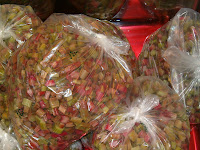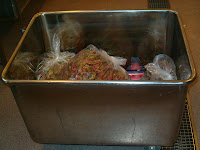"All is Safely Gathered In"
Part 1: From Bush to Bottle
We have beautiful rhubarb, red currants, black currants and gooseberries on the farm. In the forests around us are cloudberries, blueberries and lingon. Each year these fruits are picked, frozen and then processed in various ways. Last year Papa bought a Hydro-press from Germany and it was so slick to set it up and extract the juices from the rhubarb, red currants, and black currants that are turned into fruit syrups called saft (pronounced "soft") as well as sparkling red currant jelly which is eaten with many meat dishes in Swedish cooking and sylts (soft-set jam toppings).
A few weeks ago it was time to take the cleaned and chopped rhubarb out of the freezers, thaw it in the large stainless steel bins, and hydro-press out the juice. We had an abundant harvest this year, close to 180 litres of frozen rhubarb. It was so bright and fresh ranging from light green to brilliant pink all the way to deep red.
 Once it was thawed it went into the Hydro-press for the juice to be extracted. The Hydro-press works on the principle of a large interior rubber bladder with all the fruit around it and a filtering net between the fruit and the perforated outer metal sleeve. As the bladder fills with water the fruit is pushed against the net and the juice flows through the holes in the sleeve, down into the moat and out the spout into a bucket. It is clear and clean and works surprisingly quickly.
Once it was thawed it went into the Hydro-press for the juice to be extracted. The Hydro-press works on the principle of a large interior rubber bladder with all the fruit around it and a filtering net between the fruit and the perforated outer metal sleeve. As the bladder fills with water the fruit is pushed against the net and the juice flows through the holes in the sleeve, down into the moat and out the spout into a bucket. It is clear and clean and works surprisingly quickly. Here the fruit is loaded in all around the bladder. Then the liner is brought up and over, the lid put on and bolted down, and the water turned on into the bladder. In just a matter of minutes the juice begins to flow.
Here the fruit is loaded in all around the bladder. Then the liner is brought up and over, the lid put on and bolted down, and the water turned on into the bladder. In just a matter of minutes the juice begins to flow. We got about 90 litres of juice after all the pressing was finished. The residual pulp of the rhubarb was squeezed almost dry inside the press. It could be lifted out and was something like squares of a felt blanket. You can see the space between it and the bladder in the picture below.
Now some of the juice was ready to be made into rhubarb jelly so it was put aside in the cooler. Sugar was added to the rest and then it was boiled at lightening speed in the 300 litre cooker in the dairy. A very small amount of Atamon, a preservative, goes into the sweetened boiled juice, and voila! You have saft syrup - ready to bottle. The cooker has a motorized tilt mechanisn for easy pouring of the hot liquid and super easy cleanup afterward.
Reconstituted at a ratio of one part saft syrup to six parts water, we will have more than enough of this refreshing beverage to last us through the winter and into the warm days of outside work in the fields during the upcoming Spring, Summer and Fall.
Rhubarb, lingon, and red currant saft are served with meals. Black currant saft is served with desserts in the evening or on special occasions. Saftsås, a fruity dessert sauce that is poured over custards or puddings is also made from the saft syrup thickened with potatismjöl (potato flour). It is just delicious. And finally, the cloudberries, lingon, gooseberries and blueberries can be individually quick frozen for use in pies, muffins and other desserts or made into sylt and eaten on pancakes, hot cereals or with bread and cheese.
Here are some of the "fruits" of our labors, clockwise from center back... a brown glass storage bottle of red currant saft syrup, (all saft syrups are preserved in these bottles), a pitcher of reconstituted rhubarb saft (it is actually a beautiful light pink when it is first bottled then changes with time to a golden beige color), red currant jelly, wild blueberry muffins, cloudberry sylt, and reconstituted black currant saft. In the middle is lingonsylt in a two litre crock which is used on our breakfast porridge each day.
"From Bush to Bottle" has been so much fun this year!








1 comment:
All fascinating to learn about the cultural differences in food. I especially liked seeing the rhubarb press. What happens to the dry pulp after it is finished pressing? To the pigs?
What happened to all the colored fonts for the different kinds of fruit? They disappeared.
Post a Comment